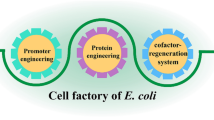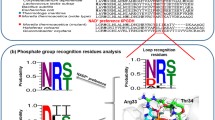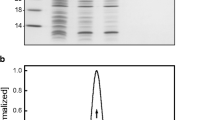Abstract
D-p-hydroxyphenylglycine (D-HPG) is an important intermediate in the pharmaceutical industry, and it is commonly synthesized by cascading D-hydantoinase (DHase) and D-carbamoylase (DCase). In this study, the stability of DCase was identified as the main problem that limits its application. Therefore, the complexed structure of AkDCase (DCase from the Agrobacterium sp. strain KNK712) with the substrate N-carbamoyl-D-p-hydroxyphenylglycine (CpHPG) (with 2.52 Å resolution) and catalytic mechanism were resolved. Based on the catalytic mechanism and electrostatic stabilization, salt bridge engineering was adopted to improve AkDCase thermostability. The best variant, AkDCaseD30A, increased the Tm by 2.91 °C and half-life (t1/2) at 40 and 60 °C by 18.43 h and 23.21 min, respectively. After AkDCaseD30A was assembled with GsDHase (DHase from Geobacillus stearothermophilus SD-1) in a single Escherichia coli cell, the recombinant strain could produce 29.53 g/L D-HPG within 12 h, with a 97% conversion and a 2.46 g/(L·h) space–time yield (STY). The titer of D-HPG increased by 40.55% compared to the E. coli cell harboring pETduet-1-AkDCase- GsDHase. The recombinant strain could be used for two cycles. Our research provides a basis for the industrial production of D-HPG.






Similar content being viewed by others
Data availability
All data generated or analyzed during this study are included in this published article and its supplementary information files.
References
Liu Y, Xie NZ, Yu B. De Novo biosynthesis of D-p-Hydroxyphenylglycine by a designed cofactor self-sufficient route and co-culture strategy. ACS Synth Biol. 2022;11(3):1361–72.
Pan X, Xu L, Li YR, Wu SH, Wu Y, et al. Strategies to improve the biosynthesis of beta-lactam antibiotics by penicillin G acylase: progress and prospects. Front Bioeng Biotechnol. 2022. https://doi.org/10.3389/fbioe.2022.936487.
Al Toma RS, Brieke C, Cryle MJ, Sussmuth RD. Structural aspects of phenylglycines, their biosynthesis and occurrence in peptide natural products. Nat Prod Rep. 2015;32(8):1207–35.
Chen SY, Chien YW, Chao YP. In vivo immobilization of D-hydantoinase in Escherichia coli. J Biosci Bioeng. 2014;118(1):78–81.
Kar S, Sanderson H, Roy K, Benfenati E, Leszczynski J. Green chemistry in the synthesis of pharmaceuticals. Chem Rev. 2022;122(3):3637–710.
Xue YP, Cao CH, Zheng YG. Enzymatic asymmetric synthesis of chiral amino acids. Chem Soc Rev. 2018;47(4):1516–61.
Wu SK, Snajdrova R, Moore JC, Baldenius K, Bornscheuer UT. Biocatalysis: enzymatic synthesis for industrial applications. Angew Chem Int Ed. 2021;60(1):88–119.
Tan X, Zhang S, Song W, Liu J, Gao C, et al. A multi-enzyme cascade for efficient production of D-p-hydroxyphenylglycine from L-tyrosine. Bioresour Bioprocess. 2021. https://doi.org/10.1186/s40643-021-00394-2.
Liu Y, Zhu L, Qi W, Yu B. Biocatalytic production of D-p-hydroxyphenylglycine by optimizing protein expression and cell wall engineering in Escherichia coli. Appl Microbiol Biotechnol. 2019;103(21–22):8839–51.
Olivieri R, Fascetti E, Angelini L, Degen L. Enzymatic conversion of N- carbamoyl-D-amino acids to D-amino acids. Enzyme Microb Technol. 1979;1(3):201–4.
Ikenaka Y, Nanba H, Yamada Y, Yajima K, Takano M, et al. Screening, characterization, and cloning of the gene for N-carbamyl-D-amino acid amidohydrolase from thermotolerant soil bacteria. Biosci Biotechnol Biochem. 1998;62(5):882–6.
Zhang D, Zhu F, Fan W, Tao R, Yu H, et al. Gradually accumulating beneficial mutations to improve the thermostability of N-carbamoyl-D-amino acid amidohydrolase by step-wise evolution. Appl Microbiol Biotechnol. 2011;90(4):1361–71.
Schwarz J, Rosenthal K, Snajdrova R, Kittelmann M, Lutz S. The development of biocatalysis as a tool for drug discovery. Chimia. 2020;74(5):368–77.
Chiu WC, You JY, Liu JS, Hsu SK, Hsu WH, et al. Structure-stability-activity relationship in covalently cross-linked N-carbamoyl D-amino acid amidohydrolase and N-acylamino acid racemase. J Mol Biol. 2006;359(3):741–53.
Oh KH, Nam SH, Kim HS. Improvement of oxidative and thermostability of N-carbamyl-D-amino acid amidohydrolase by directed evolution. Protein Eng. 2002;15(8):689–95.
Park JH, Oh KH, Lee DC, Kim HS. Modeling and kinetic analysis of the reaction system using whole cells with separately and co-expressed D-hydantoinase and N-carbamoylase. Biotechnol Bioeng. 2002;78(7):779–93.
Kabsch W. Integration, scaling, space-group assignment and post-refinement. Acta Crystallogr Sect D: Biol Crystallogr. 2010;66:133–44.
Emsley P, Cowtan K. Coot: model-building tools for molecular graphics. Acta Crystallogr Sect D: Biol Crystallogr. 2004;60:2126–32.
Murshudov GN, Skubak P, Lebedev AA, Pannu NS, Steiner RA, et al. REFMAC5 for the refinement of macromolecular crystal structures. Acta Crystallogr Sect D: Biol Crystallogr. 2011;67:355–67.
Frisch MJ, Trucks GW, Schlegel HB, Scuseria GE, Robb MA et al. Gaussian 16 Rev. A.03 Vol. Wallingford, CT; 2016
Jakalian A, Bush BL, Jack DB, Bayly CI. Fast, efficient generation of high-quality atomic charges. AM1-BCC Model I Method J Comput Chem. 2000;21(2):132–46.
Jakalian A, Jack DB, Bayly CI. Fast, efficient generation of high-quality atomic charges. AM1-BCC model: II. Parameterization and validation. J Comput Chem. 2002;23(16):1623–41.
Case DA, Berryman JT, Betz RM, Cerutti DS, Cheatham TE, et al. Amber 16. San Francisco: University of California; 2016.
Jurrus E, Engel D, Star K, Monson K, Brandi J, et al. Improvements to the APBS biomolecular solvation software suite. Protein Sci. 2018;27(1):112–28.
Dolinsky TJ, Czodrowski P, Li H, Nielsen JE, Jensen JH, et al. PDB2PQR: expanding and upgrading automated preparation of biomolecular structures for molecular simulations. Nucleic Acids Res. 2007;35:W522–5.
Jorgensen WL, Chandrasekhar J, Madura JD, Impey RW, Klein ML. Comparison of simple potential functions for simulating liquid water. J Chem Phys. 1983;79:926–35.
Berendsen HJC, Postma JPM, Vangunsteren WF, Dinola A, Haak JR. Molecular dynamics with coupling to an external bath. J Chem Phys. 1993;81:3684–90.
Darden T, York D, Pedersen L. Particle mesh ewald – An N.LOG(N) method for ewald sums in large systems. J Chem Phys. 1993;98(12):10089–92.
Ryckaert JP, Ciccotti G, Berendsen HJC. Numerical-integration of cartesian equations of motion of a system with constraints-molecular-dynamics of n-alkanes. J Comput Phys. 1977;23:327–41.
Roe DR, Cheatham TE. PTRAJ and CPPTRAJ: software for processing and analysis of molecular dynamics trajectory data. J Chem Theory Comput. 2013;9(7):3084–95.
Humphrey W, Dalke A, Schulten K. VMD: visual molecular dynamics. J Mol Graphics Modell. 1996;14(1):33–8.
Xiuzhen G, Qinyuan M, Hailiang Z. Distribution, industrial applications, and enzymatic synthesis of D-amino acids. Appl Microbiol Biotechnol. 2015;99(8):3341–9.
Lee S-C, Chang Y, Shin D-M, Han J, Seo M-H, et al. Designing the substrate specificity of D-hydantoinase using a rational approach. Enzyme Microb Technol. 2009;44(3):170–5.
Chao YP, Fu H, Lo TE, Chen PT, Wang JJ. One-step production of D-p-hydroxyphenylglycine by recombinant Escherichia coli strains. Biotechnol Prog. 1999;15(6):1039–45.
Nakai T, Hasegawa T, Yamashita E, Yamamoto M, Kumasaka T, et al. Crystal structure of N-carbamyl-D-amino acid amidohydrolase with a novel catalytic framework common to amidohydrolases. Structure. 2000;8(7):729–37.
Cai YJ, Hai Y, Ohashi M, Jamieson CS, Garcia-Borras M, et al. Structural basis for stereoselective dehydration and hydrogen-bonding catalysis by the SAM-dependent pericyclase Lepl. Nat Chem. 2019;11(9):812–20.
Cui H, Eltoukhy L, Zhang L, Markel U, Jaeger KE, et al. Less unfavorable salt bridges on the enzyme surface result in more organic cosolvent resistance. Angew Chem Int Ed. 2017;60(20):11448–56.
Jones BJ, Lim HY, Huang J, Kazlauskas RJ. Comparison of five protein engineering strategies for stabilizing an alpha/beta-hydrolase. Biochemistry. 2017;56(50):6521–32.
Cao JR, Fan FF, Lv CJ, Wang HP, Li Y, et al. Improving the thermostability and activity of transaminase from Aspergillus terreus by charge-charge interaction. Front Chem. 2022. https://doi.org/10.3389/fchem.2021.664156.
Schymkowitz J, Borg J, Stricher F, Nys R, Rousseau F, et al. The FoldX web server: an online force field. Nucleic Acids Res. 2005;33:W382–8.
Rindfleisch S, Krull M, Uranga J, Schmidt T, von Pappenheim FR, et al. Ground-state destabilization by electrostatic repulsion is not a driving force in orotidine-5 ’-monophosphate decarboxylase catalysis. Nat Catal. 2022;5(4):332–41.
Nanba H, Yasohara Y, Hasegawa J, Takahashi S. Bioreactor systems for the production of optically active amino acids and alcohols. Org Process Res Dev. 2007;11(3):503–8.
Hu X, Lin B. Efficient production of D-HPG with an immobilized transgenic strain E. coli LY13–05. Biotechnol Biotechnol Equip. 2015;29(5):1003–10.
Funding
This work was financially supported by the National Key R&D Program of China (Grant No. 2021YFC2100100), the General Program of National Natural Science Foundation of China (22178146), the Program for Young Talents in China, and the Fundamental Research Funds for the Central Universities (JUSRP622011).
Author information
Authors and Affiliations
Contributions
LDZ and CZG conceived the study. LDZ and WS made contributions to the design of the experiments, the acquisition of data, the analysis and interpretation of data and contributed to manuscript writing. WQW, CG, XLC, JL, LML and JW conceived and organized the study, helped to draft the manuscript and revised the manuscript. All authors read and approved the final manuscript.
Corresponding author
Ethics declarations
Conflict of interest
The authors declare that they have no competing interests.
Ethical approval
This article does not contain any studies with human participants or animals performed by any of the authors.
Consent for publication
All authors approved the consent for publishing the manuscript to Systems Microbiology and Biomanufacturing.
Supplementary Information
Below is the link to the electronic supplementary material.
Rights and permissions
Springer Nature or its licensor (e.g. a society or other partner) holds exclusive rights to this article under a publishing agreement with the author(s) or other rightsholder(s); author self-archiving of the accepted manuscript version of this article is solely governed by the terms of such publishing agreement and applicable law.
About this article
Cite this article
Zhang, L., Gao, C., Song, W. et al. Improving D-carbamoylase thermostability through salt bridge engineering for efficient D-p-hydroxyphenylglycine production. Syst Microbiol and Biomanuf 4, 250–262 (2024). https://doi.org/10.1007/s43393-023-00176-1
Received:
Revised:
Accepted:
Published:
Issue Date:
DOI: https://doi.org/10.1007/s43393-023-00176-1




